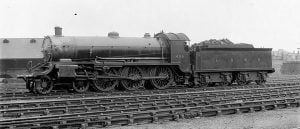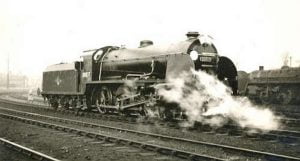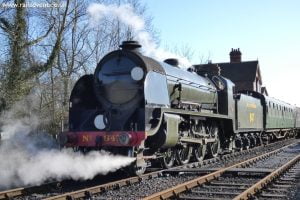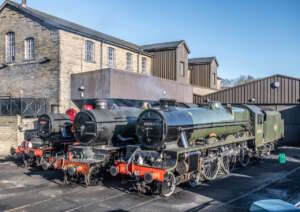Built to haul a variety of freight trains on the London & South Western Railway, the Urie S15s would operate right up to the last few years of steam on the Southern Region.
Once looking back on the class’ working careers, we will then see how many engines have been saved for preservation.
LSWR / SR S15 Class
In the Mid-1910s, there was a lack of locomotives to haul freight traffic out of the ports the LSWR served. Some duties, such as the milk trains, needed a fast engine at the head in order to get the milk to London in a timely manner.
After World War 1 Robert Urie, Chief Mechanical Engineer, returned to the project after producing his Mixed Traffic H15 class.
Design and Construction
Using his experience from the H15s, Urie adopted the same 4-6-0 wheel arrangement, but with reduced coupled wheel diameter for greater adhesion for the freight duties the S15s would carry out.
Major components, such as boiler and cylinders could be swapped with both H15 and N15 classes, built for Mixed Traffic and Express Passenger trains respectively.
The basic dimensions for the class as built include: 4-6-0 wheel arrangement (coupled wheels – 5 foot (ft) 7 (in)), boiler pressed at 180 lbf/in2, two cylinders (outside) (21in diameter and 28in stroke), total weight (including tender) came in at 135 long tons and tractive effort of 28,200 lbf.
- Order No.S15, 1920 – No.497 to 501 – five engines
- Order No.A16, 1920 – No.502 to 506 – five engines
- Order No.C16, 1920 – No.507 to 511 – five engines
- Order No.E16, 1921 – No.496,512 to 515 – five engines
- Order No.E90, 1927 – No.823 to 832 – ten engines
- Order No.E158, 1927 – No.833 to 837 – five engines
- Order No.E630, 1936 – No.828 to 847 – ten engines
Orders S15 to E15 formed the first batch of 20 engines. These were built to Urie’s design and only saw a couple of years service under the LSWR before the company was absorbed into the Southern Railway in 1923.
The second batch, made from orders E90 and E158, started to enter traffic from 1927. This batch was produced with Maunsell as CME, who altered the original Urie design. Cylinder diameter was reduced to 20 1/2in, valve travel was increased, larger outside steam pipes were fitted and boiler pressure raised to 200 lbf/in2. These changes resulted in improved performance from the S15 and an increase in tractive effort to 29,860 lbf.
Measures were taken to increase the class’ route availability on the Southern Railway, by fitting the Ashford-style cab to the whole batch and pairing the shorter six-wheeled 4,000-gallon tenders, which allowed the class to operate trains on the Western Section.
For the third and final batch, there was a 5-year gap between being ordered in 1931 to the first engines being completed in 1936. This was caused by the falling freight traffic, an impact caused by The Great Depression of the 1930s. Only two notable changes were made, these being reducing the total weight of the engines and fitting smoke deflectors. At high speeds, exhaust steam and smoke had a tendency to drift into the driver’s vision. Smoke deflectors helped improve visibility.

Performance in Service
The class mostly stayed on the Western Section of the Southern Railway, being allocated to duties between London depots such as Nine Elms and Hither Green and Coastal destinations such as Southampton and Exeter. They were a common site on night express trains and would also be used on passenger trains when needed.
Decline and Withdrawal
Being good engines for both passenger and freight traffic, the S15s had plenty of trains to haul. The first withdrawals didn’t come til 1962 when four of the class were removed from traffic. In 1964, the final Ex-LSWR built engine, No.30499, was taken out of service. The final six locomotives steamed for the last time under BR ownership in 1966.

Preservation
All seven members which have survived into preservation all entered Barry Scrapyard before being purchased by Groups etc for restoration.
- 499 – Undergoing restoration at the Mid Hants Railway, owned by the Urie Locomotive Society. The Society purchased 499 in 1980, with the engine spending 16 years at Barry. Initially, the locomotive was brought as spares for the Society’s other S15 506. When 506 was restored, the Society started to source parts to eventually restore 499 at the Mid Hants Railway. Some components have been restored or replaced ready for use, such as the frame and a new cab. Details about the 499 Appeal, set up to raise funds towards 499’s restoration, can be found on the Urie Locomotive Society here
- 506 – Undergoing overhaul at the Mid Hants Railway, owned by the Urie Locomotive Society. The first S15 purchased by the Society. Leaving Barry in 1976, the engine would steam again in 1987 after buying another boiler for the engine. With using parts from 499, 506 would steam for 14 years before its ticket expired in 2001. As of Early December 2018, the overhaul is progressing well at Ropley, with the boiler passing its out of frame test on December 1st, 2018. More information about the engine can be found here.
- 825 – Undergoing overhaul at the North Yorkshire Moors Railway, owned by the Essex Locomotive Society. 825 spent just over two decades in Barry Scrapyard before leaving in 1986. In order to restore 825, many parts from fellow class member 841 were used. Its last boiler ticket expired in 2013, with an overhaul currently being carried out. Click here to read the last overhaul update.
- 828 – Undergoing overhaul at the Mid Hants Railway, owned by the Eastleigh Railway Preservation Society. The Society purchased 828 in 1981 and moved the engine to where it was built, Eastleigh Works, where after almost 12 years of restoration the locomotive moved under its own steam in 1992. On its first boiler ticket, numbered E828, the locomotive hauled several mainline tours in the 1990s, mostly across Ex-Southern Railway tracks. The last few years on its ticket saw E828 operate on the Swanage Railway. Moving to the Mid Hants Railway in 2004 to start E828’s overhaul, current work involves building the spark arrestor and smokebox. Want to find out more or support 828? Please visit the Eastleigh Railway Preservation Society’s website here.
- 830 – Awaiting restoration at the North Yorkshire Moors Railway, owned by the Essex Locomotive Society. Originally purchased by the Maunsell Locomotive Society for use on the Bluebell Railway when restored, 830 was then put up for sale and brought by the Essex Locomotive Society, owners of 825 and 841.
- 841 – Awaiting restoration at the North Yorkshire Moors Railway, owned by the Essex Locomotive Society. Rescued from Barry in 1972 and restored into full working order 2 years later, 841 moved to its current home on the North Yorkshire Moors Railway in 1979. It’s last boiler certificate ran out in 1994. As mentioned earlier, major components from 841 were used to restore 825, which now has left only 841’s frame, stored at Grosmont.
-

847 at Sheffield Park // Credit: RailAdvent 847 – Operational on the Bluebell Railway, owned by the Maunsell Locomotive Society. After joining forces with another group by a merger, 847 plus a tender was brought in 1978. Between 1984 and 1992 the engine was restored and ran for 5 years before withdrawn for repairs. 2008 saw the start of 847’s first overhaul in preservation, which was completed in 2013. Current boiler ticket expires in 2023.
We hope you have enjoyed this week’s Class Information. Already covered in our Sole Survivor series is the LSWR/SR N15 “King Arthur”, the Express Passenger version of the S15s. To find out more about this class and the last class member left, click here.
Where Next?
News Homepage
For the Latest Railway News
RailAdvent Online Shop
Framed Prints, DVD’s / Blu-Ray’s and more
LocoStop – The RailAdvent Community
Come and share your railway pictures






Responses
Please don’t think I demean these locos in any way by referring to them by number! Its only quite recently I got a laptop, there were no computers years ago! ( to look up designers or year of build etc,) or a magic phone in your pocket to be of any assistance in a rule 55 situation!, at that point of time in my life I was still trying to get the hang of light switches !!
Long time ago but still some brain activity,It was 30s as I called them,well you couldn’t walk 12 lanes at Exm Jct looking for a urie or maunsel?, 30825 or 30847 (found them on rail steam loco)looks like theyre preserved, Find your engine,get it ready,then make the tea,in that order!but it looks like the aforementioned were at Exm jct shed,plus others that have been scraped of course,but I would of undoughtably fired them…pretty sure they didn’t have sprinklers,( so damp the coal with the pep pipe when going backwards!!)
So sure we had these at Exm jct,late 50s early 60s,I called them 30s or 31s,but they had smoke deflectors,we would put a tarpaulin up,tender to cab, still got wet n cold though, running backwards with a meldon quarry stone load behind !! and dragging up the St Davids incline/bank to central was something else. They always done it though,give them their due.
Orders S15 to E15 formed the first batch of 20 engines.
Should be E16.
[…] Using his experience from the H15s, Urie adopted the same 4-6-0 wheel arrangement, but with reduced coupled wheel diameter for greater adhesion for the freight duties the S15s would carry out. LSWR/SR S15 Class steam locomotives – Class Information […]